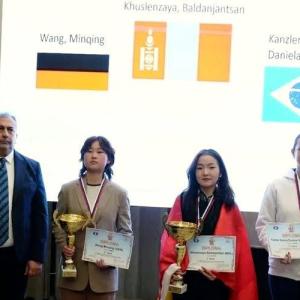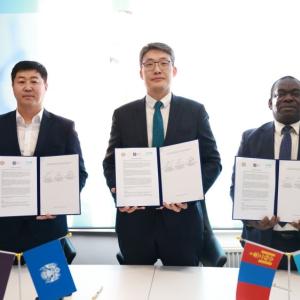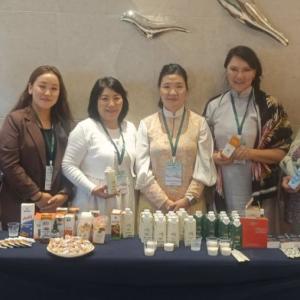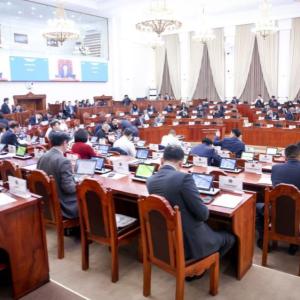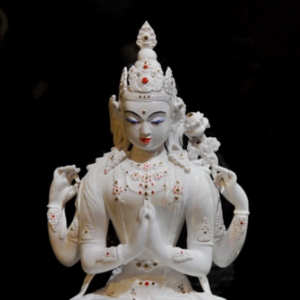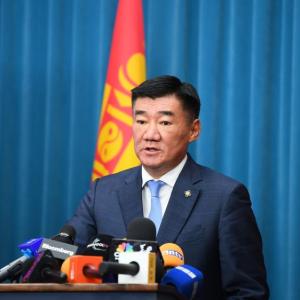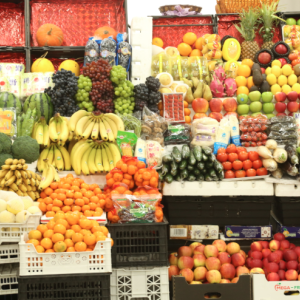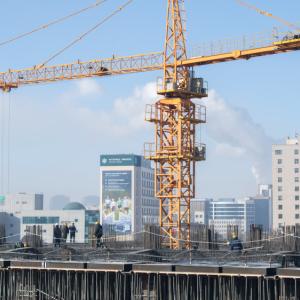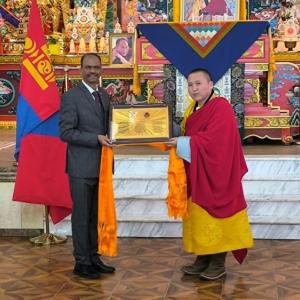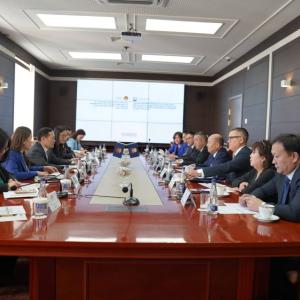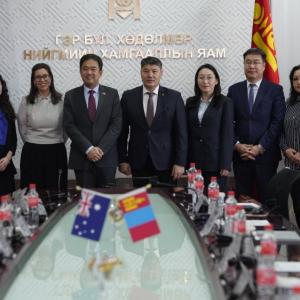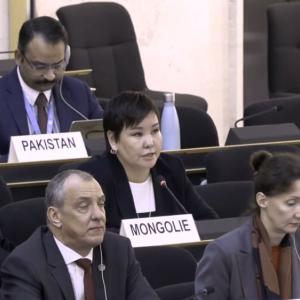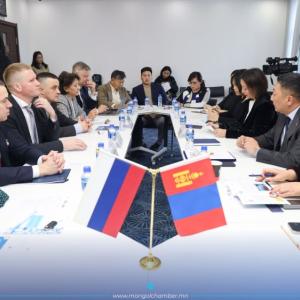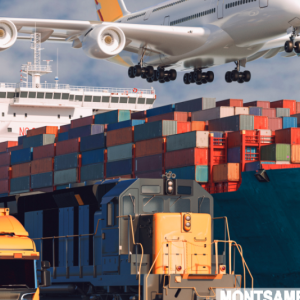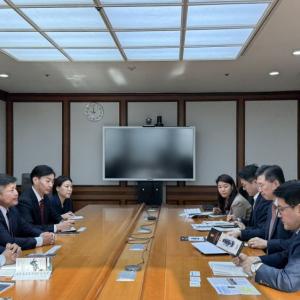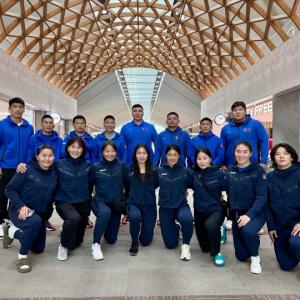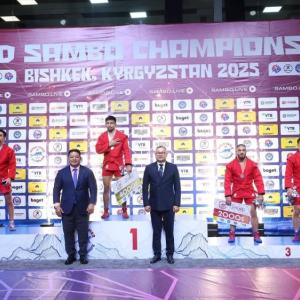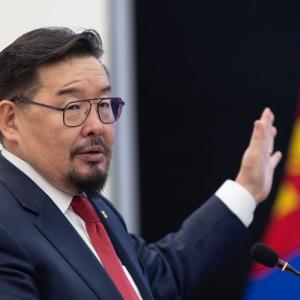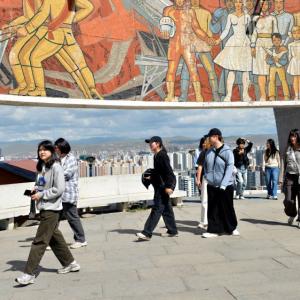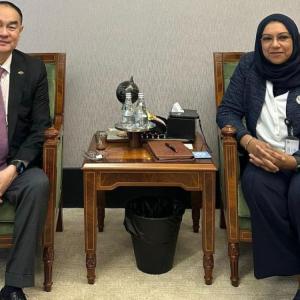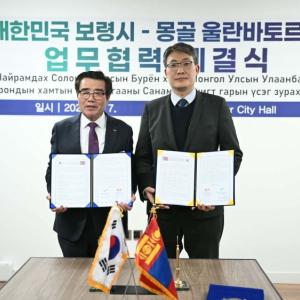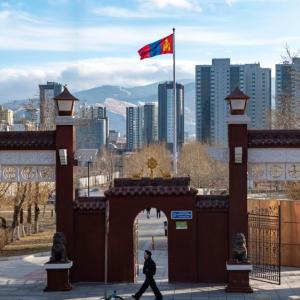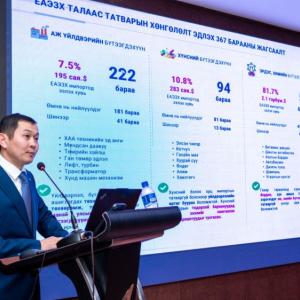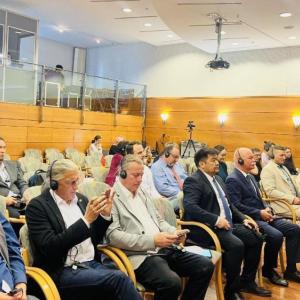30 Years of Friendship, Trust and Cooperation
The Mongol Messenger
Ulaanbaatar /MONTSAME/ On the
occasion of the 30th anniversary of the establishment of diplomatic relations
between Mongolia and the Republic of Korea, which is being commemorated this
year, Minister of Foreign Affairs of Mongolia D.Tsogtbaatar gave an interview
for MONTSAME News Agency.

- This year commemorates the 30th anniversary of diplomatic ties between Mongolia and the Republic of Korea. What are planned for the anniversary?
First and foremost, I would like to extend my
congratulations to our readers on the occasion of the diplomatic anniversary
between Mongolia and the Republic of Korea. Thirty years may seem a short
period of time, nonetheless, they were filled with vital and significant events
for the relationships between the two nations.
During this period, the relations have
developed successfully in a wide array of fields of politics, trade, economy,
investment, culture, education and humanitarian on the basis of the Comprehensive
Partnership.
Honoring the friendly relationship of the two
nations, 2020 has been announced as a “Mongolia
and the Republic of Korea Friendship Year” and 30 special events are
planned. For instance, Mongolian Cultural Days and Cinema Days in Seoul, as well as joint academic symposium,
diplomatic anniversary book launch, photo exhibition and cultural performances
in Ulaanbaatar city will be organized.
With a view to enhance political dialogues, we
are considering to organize some high-level visits this year. The working
committee to organize the celebration of the 30th diplomatic
anniversary is headed by Minister of Environment and Tourism N.Tserenbat, with Vice Minister of Foreign Affairs of
Mongolia B.Battsetseg and Vice Minister
of Education, Culture, Science and Sports G.Ganbayar as deputy-heads.

Signing of the Protocol on the Establishment of Diplomatic Relations between the Republic of Korea and Mongolia, March 26, 1990.
-
What
position does the ROK take up in the foreign policy of Mongolia? How would you
evaluate the current state of the bilateral relations of the two countries and
future trends?
A concept of Third Neighbor Policy first
emerged in the foreign policy of Mongolia, soon after Mongolia made a
transition to the democracy and market economy in the 1990s, pursuing an open and
multi-base foreign policy. The Third Neighbor Policy refers to developing partnership
relations and cooperation with highly developed countries while maintaining
good neighbor friendly relations and wide-ranging cooperation with two
neighbors, Russia and China.
Within the framework of this policy, the
Republic of Korea along with the USA, Japan, European Union, India and Turkey are
defined as third neighbors of Mongolia, and the cooperation between our two
nations have been continuously moving forward in the last three decades, as of today reached the level of “Comprehensive
Partnership”.
The two countries share common values of
respecting human rights, freedom, democracy and market economy, which serve as
a solid foundation for strong relationship between us. There is a phrase “A
good start is a key of success”. Since
the good foundation was established at the outset of our cooperation, the
relations between Mongolia and the ROK have been growing at a fast pace,
achieving satisfactory results.
President
of Mongolia P.Ochirbat’s visit to the ROK in 1991 for the
first ever visit at a level of a head of
state and President of ROK Kim
Dae-jung paid a reciprocal visit to Mongolia in 1999. Since that time, more
than 30 mutual visits at levels of President, Prime Minister, Minister of
Foreign Affairs were paid. It is
believed that the political trust between the two nations have been
strengthened in the past with well-established legal foundation for bilateral
ties.
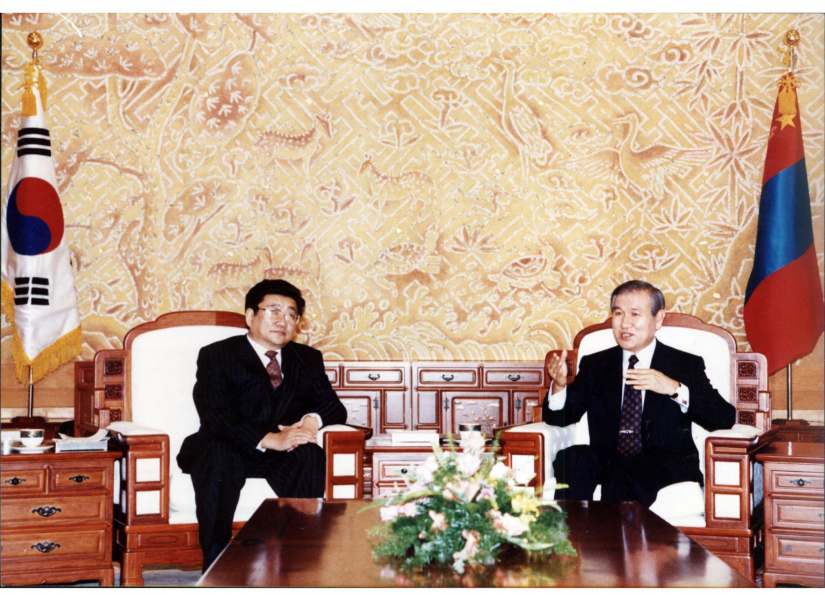
There are more than 50 intergovernmental treaties
and agreements, regulating the relations of the two countries. A far-reaching
dialogue has been achieved at the level of corresponding government ministries
and organizations. Friendship and public organizations have also been fulfilling
their duties of “public diplomacy” effectively.
I would like to take this moment to express my deep
gratitude for each individual involved in the growth of the Mongolia-ROK relations to the current level, especially
the government and civil service officers, diplomats, scholars and the public.
The ROK is an important trade and investment
partner of Mongolia. The trade turnover of 2019 totaled USD 300 million and Korean investment to Mongolia reached
USD 550 million. The largest Mongolian community abroad or 48,000 people are currently residing in ROK and the number of citizens to
mutually travel to Mongolia and the ROK exceeds 200,000. Such a high number of mutual
travels by both citizens is further
evidence to demonstrate the extent of the relationship.
As I mentioned earlier, reinforcing and developing
bilateral ties and partnership with the ROK further is one of the foreign
policy priorities of Mongolia. Furthermore, in the scope of the multi-pillar foreign policy, we seek to take
more active part in the multilateral cooperation of the Asia and the Pacific
region, particularly in the Northeast Asia.
In spite of the fact that the Northeast Asian
region, where Mongolia is situated in, holds great opportunities for future
development, conditions and environment to utilize the opportunities are not commonly
available and mechanism for regional cooperation is limited.
We are looking to a brighter future ahead of us
where we are able to work together with the ROK on the regional stage, and gain
from our joint participation in the mining, infrastructure and energy
developments, covering the whole region. Shaped by those goals, we support the
“New Northern Policy” initiative for regional development by ROK President Moon Jae-in.

Mongolia is ranked in the first ten countries in the world with its rich
natural resources. South Korea is a global leading country in terms of its new
advanced technology and know-how, and particularly, the information technology development.
There are ample opportunities for growth
for mutually beneficial cooperation by bringing together the advantages and resources
of the two countries. Not to mention the various fields with abundant
possibilities for cooperation, such as education, health, road and transport,
agriculture and tourism.
-
Heads
of the governments of the two nations have paid mutual visits in recent years.
What were the main outcomes? A topic on bringing the current level of relations
to the “Strategic Partnership” was on agenda of the visits. What type of
cooperation should be on the focus for further development in the connection?
Yes. The frequency of mutual visits by heads of
states and governments has grown over the last few years. Prime Minister of Mongolia U.Khurelsukh made his first official trip abroad from
the ROK in January 2018. Only after less than a year in March 2019, ROK Prime Minister Lee Nak-yeon made a
reciprocal visit to Mongolia.
The talks during the visits held in warm and
friendly atmosphere, and the Prime Ministers have built mutual trust and
friendly brotherhood relations with each other, which were crucial for
strengthening the bilateral ties, specifically for intensifying people-to-people
relations.

Numerous important issues were discussed and
settled during the visits. For instance, two sides agreed to carry out essential
projects and programs aimed at reduction of Ulaanbaatar city’s air pollution with
USD 500 million soft loan by the Government of the ROK within the framework of the program
under implementation by the Government of Mongolia in cooperation with the International
Monetary Fund (IMF).
A tangible outcomes of the visits include favorable
decision on the construction of apartment complexes Solongo and a rental
apartment complex in the mountain pass of Bayangol in Ulaanbaatar.
ROK
leader Moon Jae-in put forward a proposal to bring the present “Comprehensive
Partnership” between the two countries to the level of “Strategic Partnership”.
During the 2006 visit of President
of ROK Roh Moo-hyun to Mongolia, the
countries declared to maintain “Good neighbor friendly cooperation”, and in
2011, it was announced that the bilateral relations will be developed in all
areas on the basis of “Comprehensive Partnership” during the visit by President
Lee Myung-bak.
We are now carefully studying what principles
and contents should be inherent in the “Strategic Partnership”, and exchanging
viewpoints with senior diplomats and scholars and researchers on this matter.
From my point of view, the “Strategic Partnership” shall be made up of five vital
pillars of cooperation of a/ politics and security; b/ trade, investment and economy;
c/ education, health, culture, humanitarian, environment and tourism; d/ the citizens and consular affairs; e/ on
the international and regional fora.
Active discussion is underway with the Korean
side on the objectives to set in each direction. We see that day to declare the
higher level of partnership has drawn near.
-
Would
you please give us some information on the present status of the bilateral
trade and investment, as well as opportunities to attract South Korean business
entities and investors to the Mongolian market and development projects?
Trade and investment growth and mutually
beneficial economic cooperation are of great consequence for expanding
bilateral ties. During the early years of diplomatic relations, trade turnover
was estimated at around USD 270,000, and the number has climbed to USD 294.8
million by 2019, with over a thousand-fold increase. This is the number that
should not be underrated. But we have more things needed to be done in this
area.
The ROK has become the sixth largest trade
partner of Mongolia. I am delighted that many leading well-known Korean corporations participate in Mongolia’s
largest development projects. Direct investment of the ROK to Mongolia began
back in 1990 and the total investment of Korean business enterprises and
companies in the past totaled over USD 560 million, to be placed tenth by its
volume of foreign direct investment. Today, there are 2532 ROK-invested
companies operating in the tourism, industry, retail and wholesale and
hospitality areas of Mongolia.
The economy, cutting-edge technology and expertise
of ROK is the fourth largest in Asia.
Mongolia always strives to bolster and develop the economic and trade
cooperation with the ROK. With a view to increase economic cooperation, a Joint committee between the governments was set up in 2015, yielding
benefits.
As trade facilitation measures, having quarantine
standards and solving challenges in transport logistics are deemed to pave the
way for trade growth, preparation must be ensured as early as possible for
establishing economic partnership agreement with the ROK. A relevant study was performed in 2018 in
collaboration of Korean side, with a
positive conclusion that volume and types of export commodities of Mongolia are
possible to increase.
While on the subject, I should mention that
Mongolia has joined the Asia-Pacific Trade Agreement (APTA) and will start its
implementation from July 1, 2020. We are confident that participation in the APTA
will open up broad possibilities for extending the trade and economic
partnership with the ROK.
We have abundant of unused resources. Advancing
cooperation with the ROK is within our reach by introducing their investment
and environment friendly, breakthrough technologies into Mongolia’s industry,
infrastructure, road transport, construction, urban development, maritime
transport, agriculture and food production areas.
-
The
Official Development Assistance (ODA) of the ROK has apparently made
significant contributions to the social and economic development of Mongolia. Which
areas are most covered by the ROK’s soft loans and assistances?
Indeed, the ODA of the Government of the ROK has played a
considerable role in socio-economic development
of Mongolia. The Government and the
people of Mongolia are truly grateful the ROK Government for providing supports and assistance since Mongolia
moved toward market economy. The ROK Government placed Mongolia on its ODA Recipient list in 1991,
to grant aids totaling USD 240 million between 1991 and 2018. Soft loans from
South Korea to Mongolia started in 1993.
In the scope of the Extended Fund Facility
arrangement by the IMF in Mongolia, the ROK Government has resolved to issue USD 500 million soft loan to
Mongolia, and its general agreement was established during Mongolian Prime
Minister Khurelsukh’s 2018 visit to the country. The soft loan will be used for
projects targeting to reduce air pollution in Ulaanbaatar city. For example, the
two sides agreed to build the aforementioned apartment complexes and to improve
laboratory capacity of the Center for Nature and Environment, which will help
Mongolia deal with its most critical problem of air pollution.
In addition, as part of the USD 300 million
soft loan by the ROK Government, projects to build National Diagnosis and
Treatment Center and thermal power plant in 10 aimags and legislation package
project are underway.
The Export–Import Bank of Korea at the ROK Government’s Economic
Development Cooperation Fund (EDCF) opened its representative office in
Ulaanbaatar last year to accelerate the effective implementation of the
projects.
ROK’s long
term soft loans are important to realize the programs and projects of utmost
importance for bolstering Mongolia’s basic infrastructure and socio-economic
development. We will continue to work closely
with the ROK Government to carry out projects addressing the social
welfare and to increase the benefits of loans and assistance.
-
The
number of Mongolians to live and work in ROK has reached almost 50,000 and the
mutual travels of citizens between the two countries are growing year on year. What
steps is the Ministry of Foreign Affairs taking to facilitate travels for citizens
of the two nation?
One of the important conditions to expand the
bilateral cooperation is free travel between the citizens. Following the
growing relationship, the traffic of mutual travels between the citizens are increasing, with the number of people to travel between the two countries passed
200,000 in 2019. The number is made up of more than 103,000 Mongolian nationals
to travel to South Korea and some 97 thousand Korean people to Mongolia.
There are 48,000 Mongolian nationals residing
in ROK, representing the highest
number of Mongolian nationals to live in a foreign country. The flow of mutual
travel is expected to grow in the future.
Safeguarding the rights and interests of
Mongolian citizens abroad and creating favorable travelling conditions is one
of the foremost goals of the Mongolian Government. In connection with this, the Ministry of Foreign
Affairs has been giving out essential travel guidelines, recommendations and
warning to our citizens and has teamed with the ROK Embassy to create a public
outreach campaign “Travel Responsibly”.
Moreover, a number of requests and proposals,
namely, easing difficulties in visa application and shortening the visa
process, have been brought forward to the Korean side at various levels, beginning
to yield some results.
The Ministry of Justice of ROK revised its visa regulations in September 2019, expanding the
scope of eligibility for multiple-entry visas and easing short-term visa
requirements for family members of foreign workers in the country under labor
contract. We will keep working with the ROK side on building roadmap with envisioned
goals of facilitation of mutual travels by the citizens and visa-free travel further
ahead.
-
There
are increasing number of Mongolian students who wish to learn Korean language,
are interested in Korean culture, and to study in ROK. Please tell us about the
cultural and educational cooperation of Mongolia and the ROK.
The history of the Mongolia- ROK relationship dates back a long time and the two
nations have some common traits of language, culture and traditions. The number
of Mongolian students to study in the ROK’s universities and language training institutions
has been growing to reach more than 8900 as of today, and among other
countries, third-highest number of Mongolian students are in South Korea.
Within the sphere of the educational
partnership, Mongolia-Korea teacher’s Exchange
Program has been under successful implementation since 2012, involving over 300
teachers from secondary schools of Mongolia. Fruitful arts and cultural
cooperation is ongoing. The two countries maintain the tradition to organize Mongolian
Naadam Festival and Mongolian Cultural Days in ROK’s major cities and districts.
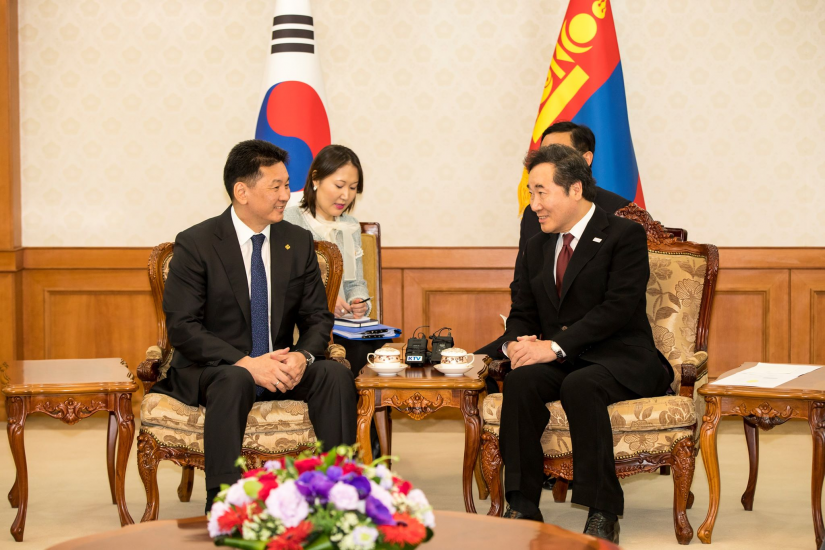
As the Korean K-Pop has a very large number of
young fans in Mongolia, development of “M-Pop” culture in Mongolia, inspired by
the K-Pop, was discussed at Prime Minister of ROK Lee Nak-yeon’s visit to Mongolia in 2019. I see that this can
be a new direction of bilateral cooperation.
With its Fourth Industrial Revolution, ROK leads the world in expertise of
training professional workforce in innovation, nanotechnology and information
technology. Therefore, future collaboration with the country by learning from
their experience on the development of science and technology parks, innovation
and training young Mongolians in information technology, computer programming
and engineering are highly desirable for preparing our future professional workforce.
-
More
tourists from the ROK are interested in travelling to Mongolia. What kind of
works are being carried out to attract Korean tourists and promote Mongolia?
Since establishing diplomatic ties, the
people-to-people exchanges have been experiencing gradual and constant growth
with more rapid rise recently. In the beginning of the 1990s, passengers
usually had to spend around two days to travel to South Korea via Beijing and
Tokyo or Hong Kong. Since 1994, MIAT Mongolian Airlines and since 1996, Korean
Air started operating direct flights between Ulaanbaatar and Seoul, bringing
impetus to the air relations and tourism growth and facilitating mutual
travels. More airlines, including Air
Busan and Asiana Airlines have launched their services in the destinations
since then.
The number of Korean nationals to travel to Mongolia,
which was estimated at 5,000 in 1999, grew by 20 times to reach 97,000 in 2019.
Around 20 percent of the total tourism arrivals in Mongolia in 2019, which
equaled to 577,000, was Korean visitors.
Various tour packages, such as eco-tourism,
entertainment and cultural travels are open for South Korean travelers. We are
also actively making efforts to enhance the tourism industry and increase the
number of tourists, for instance, we are participating in international major
tourism events and trade fairs to promote Mongolia abroad and also planning to
establish “centers to promote Mongolia” in countries with targeted market.
Allow me to briefly say one example. There is a
world popular Korean drama that was filmed in Mongolia in 2019. It shows that
we hold a plenty of opportunities to be widely known abroad and to boost the tourism
industry with the help of development of entertainment and cultural
cooperation. I am confident that we will see a substantial growth in the number
of Korean travelers and visitors to Mongolia.
-
The
two countries have been building close collaboration on international platforms.
How is the role of Mongolia in the peace and security of the Northeast Asian
region assessed? What contributions are the two nations able to make in the
regional economic growth? Please share your views.
Making its contribution to ensuring peace and
security in the Northeast Asia is an integral part of the foreign policy of Mongolia
as the political, social and economic process in the region have immediate and
non-immediate impacts on the security and sustainable development of Mongolia.
Promotion of stability on the Korean Peninsula is
vital for maintaining regional peace and security. Not unlike the regional
states, Mongolia has consistently adhered to a position to make the Korean Peninsula
a nuclear-weapon-free zone. In this sense, Mongolia initiated the Ulaanbaatar
Dialogue on Northeast Asian Security in 2013 and has hosted international
conferences on regional security, energy, infrastructure, green growth and
humanitarian cooperation and Mayors’ Forum, Forum of Women Parliamentarians and
Youth Forum with success. The Northeast Asian states, including the ROK, were engaged
in those international events, showing their support in our initiative.
Views have been shared with the ROK on building
Northeast Asia Regional Power System Interconnection and East Asia Railway Community initiative.
You are probably well aware of the initiative by the President of Mongolia
Battulga, presented at the Eastern Economic Forum in Vladivostok city of
Russia, to have an organization comprised of regional countries within the Northeast
Asia Regional Power System Interconnection project.
Support and concerted position by regional countries are essential for putting the initiative into action and cooperation with regional countries, specifically the ROK, will be sustained further. I am convinced that the partnership between Mongolia and the ROK will have a pivotal contribution not only to the development of the two countries, but also for the region to flourish and achieve stability.
 Ulaanbaatar
Ulaanbaatar









